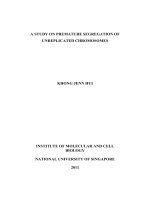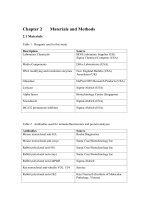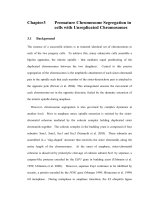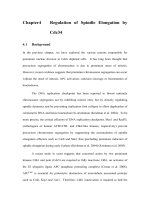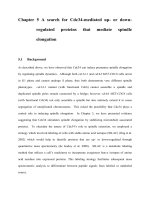Study on anatomical features of roots, stems, leaves, chemical composition and antifungal, antibacterial activities of cinnamon oil (Cinnamomum cassia (L.) J. PRESL) planted in Thanh Hoa
Bạn đang xem bản rút gọn của tài liệu. Xem và tải ngay bản đầy đủ của tài liệu tại đây (663.05 KB, 10 trang )
HNUE JOURNAL OF SCIENCE
DOI: 10.18173/2354-1059.2019-0082
Natural Sciences 2019, Volume 64, Issue 10, pp. 131-140
This paper is available online at
STUDY ON ANATOMICAL FEATURES OF ROOTS, STEMS, LEAVES,
CHEMICAL COMPOSITION AND ANTIFUNGAL, ANTIBACTERIAL
ACTIVITIES OF CINNAMON OIL (Cinnamomum cassia (L.) J. PRESL)
PLANTED IN THANH HOA
Le Van Trong1 and Tran Thi Thuy2
1
Faculty of Natural Sciences, Hong Duc University,
2
Trieu Son 4 High School, Thanh Hoa
Abstract. The paper presents anatomical features of roots, stems and leaves of
cinnamon planted in Thanh Hoa. Anatomical features of the root and stem include
epidermis, cortex, phloem, xylem and pith. Petiole and midrib have the epidermis,
phloem, xylem, pith and thick tissue, blade composed of the upper epidermis,
lower epidermis, palisade mesophyll and spongy mesophyll. The research
identified 20 chemical components of cinnamon oil, in which the major
constituents includes cinnamaldehyde <E-> (76.96 %), cinnamyl acetate <E->
(11.07 %), coumarin (5.06 %). In the sample concentration of cinnamon oil
samples exhibiting activity against 03 strains of E coli, P. aeruginosa, B. subtilis
(with MIC value from 100- 200 μl/mL) with a sterile ring diameter of 10.22 mm;
16.27 mm; 14.61 mm and 01 strain of C. albicans (MIC = 50 µl/mL) with a sterile
ring diameter of 24.45 mm.
Keywords: Anatomy, leaves, roots, stems, cinnamon oil.
1. Introduction
Cinnamon (Cinnamomum cassia (L.) J. Presl) belonging to family Lauraceae [1],
has been utilized as a potential therapeutic agent in various cultures for centuries. In
Vietnam, cinnamon planted in tropical natural forests, from the North to the South. The
main products of cinnamon are cinnamon bark and cinnamon essential oil which have
been widely used in pharmaceutical industry, processing industry and animal
husbandry. The parts of the cinnamon such as bark, leaves, flowers, roots all contain
essential oils, especially in the bark with the highest content of essential oils, sometimes
reaches 4 - 5 %. Cinnamon bark is used as a spice to improve flavor of local food
preparations. Cinnamon bark and leaf oils are used as flavor ingredients and also in
cosmetics and pharmaceutical preparations.
Received September 24, 2019. Revised October 17, 2019. Accepted October 24, 2019.
Contact Le Van Trong, e-mail address:
131
Le Van Trong and Tran Thi Thuy
There have been many studies in the world and in Vietnam on cinnamon oil.
Research by P.A.Paranagama et al. (2001) [2] showed that the major constituents of
cinnamon fruit oil were - and - cadinene (36.0 %), T-cadinol (7.7 %) and caryophyllene (5.6 %). About 84 % of cinnamon fruit oil comprised sesquiterpenes,
while other parts of cinnamon contained less than 9% of this group of compounds.
Phenyl propanoids were the major constituents of cinnamon bark and leaf oils while
root oil had monoterpenes as the major constituents (95 %).
Kamaliroosta L. et al. (2012) [3] indicated that Cinnamaldehyde was the
predominant constituent in the isolated oil. Hoang Thi Bich et al. (2017) [4] has
surveyed the biological activity of cinnamon leaf oil obtained from the enzyme method
combined with steam distillation, the results have shown that cassia oils were obtained
from the plant leaves and branches by steam-distillation (StD) and enzyme-assisted
distillation (EAD) and studied on some bioactivities. Both EAD and StD oil exhibited
antibacterial, antifungal, anti-inflammatory, cytotoxic activities and no antioxidant
activity. Enzyme treatment of these oils with Laccase-Htec2 did not alter their
biological activities.
Cinnamon is considered as one of the precious medicinal plants that have been
widely used in the daily life of Vietnamese. However, the use of this medicinal plant in
Vietnam is still folklore, studies on cinnamon are limited, especially those on
anatomical features although the research on anatomical features contribute useful
information in identifying and orienting appropriate planting sites for a variety of
human purposes. Therefore, we have collected samples to analyze the anatomical
features of roots, stems, leaves and essential chemical composition of cinnamon as the
scientific basis for the next new research.
2. Content
2.1. Materials and methodology
* Materials
Stem, bark, leaves and roots of Cinnamon were collected in Trieu Son district,
Thanh Hoa province in may 2019. Cinnamon is 2 years old and grows well. Cinnamon
was classified according to comparative morphological method of Nguyen Nghia Thin [5].
* Methodology
- Anatomical method
Using a sharp knife to create thin slices of the stem, roots, leaves, cut
perpendicularly [6]. Select the most beautiful slices to be used as a template by double
dyeing method and microscopic observation [7, 8]. All measurements were conducted
on a light microscope.
- Methods of extraction and analysis of chemical composition of cinnamon oil
Cinnamon bark oil is collected by attractive steam distillation method for 2 hours at
normal pressure according to Vietnamese Pharmacopoeia [9].
The chemical composition of cinnamon oil was analyzed at the Department of
Chemical Analysis - Institute of Natural Products Chemistry - Vietnam Academy of
Science and Technology. The analysis was performed by means of gas chromatography132
Study on anatomical features of roots, stems, leaves, chemical composition and antifungal…
flame ionization detector (GC-FID) and gas chromatography coupled with mass
spectrometry (GC-MS) [10].
The HP-5MS column had dimensions of 0.25 x 30 m x 0.25 mm and HP1 had
dimensions of 0.25 x 30 m x 0.32 mm. Process temperature were 60 oC/2 minutes;
increased the temperature 4 oC/1 minute until 220 oC, then increased the temperature
20 oC/1 minute until 260 oC, with Helium carrier gas [11].
- Test method of antifungal, antibacterial activity of cinnamon oil
+ Microorganism strains
Bacteria Gr(-): Escherichia coli ATCC 8739, Pseudomonas aeruginosa ATCC
9027
Bacteria Gr(+): Bacillus subtillis ATCC 6633, Staphylococcus aureus ATCC 6538
Mushroom (mold): Aspergillus niger ATCC 9763, Fusarium oxysporum ATCC
48112
Mushroom (yeast): Candida albicans ATCC 10231, Saccharomyces cerevisiae
ATCC 16404
Standard strains (ATCC sources, Manassas, USA) are provided by the Central
Institute of Drug Quality Control and kept in the Laboratory of Experimental Biology
(Institute of Natural Products Chemistry).
+ Standard antibiotics
Gentamycin for bacteria Gr (-), doxycycline for bacteria Gr (+) and nystatin for
mushroom (mold) and mushroom (yeast). Antibiotics are provided by Ho Chi Minh
City Testing Institute.
From the original solution mixed with distilled water and then diluted to the
required concentration: gentamycin (16 - 8 - 4 IU/mg), doxycyclin (0.4 - 0.2 - 0.1
IU/mg) and nystatin (12 - 6 - 3 IU/mg).
+ Test and evaluate results
Sample preparation: Dissolve the sample in DMSO (Dimethyl sulfoxit) 100 %
using a vortex machine at a concentration of 1 mg/ml with pure samples.
Mix a sample with DMSO 10 % on 96 template plate in a decreasing concentration
(log2 for 5 levels of concentration). Apply a sample on 96 plate (test plate) and add
microorganisms to obtain a sample concentration range of 200-100-50-25.5-12.5 μg/ml
(repeat 3 times at each concentration) with raw sample (extract) and 50-25-12.5-6.25
μg/ml with sample of purified samples. Keep in the incubator at 37 °C for 24h for
bacteria and 30 °C/48h for mushrooms.
Control sample: NaCl 0.9 % corresponding to the sample volume of the negative
control (-) and positive control (+) as standard antibiotics.
Samples were determined to be active in the absence of microbial growth at least
one test sample concentration compared to control (-) (when re-cultured at this
concentration check on agar plates CFU (Colony forming unit) value < 5). The active
expression sample was tested at different sample concentration ranges to determine the
minimum inhibitory concentration of MIC (µg/ml) which is the lowest test
concentration for which the microorganism is inhibited.
133
Le Van Trong and Tran Thi Thuy
Samples were determined to be active when the MIC≤ 200 µg/ml values for raw
samples and ≤ 50 μg/ml for purified samples.
2.2. Results and discussion
2.2.1. Anatomy of the roots
The analysis anatomical features of the cinnamon roots in Figure 1 indicate that:
The epidermis consists of a long layer of thin-filmed cells that are often tightly packed.
Figure 1 . Anatomy of the roots
1. Epidermis; 2. Cortex; 3. Phloem; 4. Xylem; 5. Pith
The cortex is massive and consists of thin-walled cells with rounded or polygonal
parenchyma cells having sufficiently developed intercellular spaces among them. The
parenchyma cells of the cortex contain abundant starch grains in them.
The transport system consists of separate bundles of phloem and xylem arranged
alternately. The xylem forms discrete strands, alternating with the phloem strands.
Sometimes the xylem occupies the centre, with the strand-like parts projecting from the
central core like ridges. The phloem is also centripetally differentiated, the protophloem
occurring closer to the periphery than the metaphloem.
Ground tissue of the pith accounts for a small proportion of the innermost part, soft
tissue consists of cells with thin membranes and relatively large size, close together so
there is no space between the cells.
2.2.2. Anatomy of the stem
The result in Figure 2 shows anatomical features of cinnamon stem, the structure
consists of: The epidermis consists of a single layer of cells and is the outermost layer of
the stem. It contains stomata and the cells are compactly arranged and do not possess
intercellular spaces. In transverse section the cells appear almost rectangular. It serves
mainly for restricting the rate of transpiration and for protecting.
The cortex lies below the epidermis, it consists of large parenchyma cell and cells
are generally regular in shape, have comparatively thin walls, and are not greatly
elongated in any direction. They are living cells and contain a moderate amount of
protoplasm. The innermost layer of the cortex is the endodermis consisting of barrelshaped, elongated, compact cells, having no intercellular spaces among them.
134
Study on anatomical features of roots, stems, leaves, chemical composition and antifungal…
The phloem strands are found on extreme ends of the vascular bundle. The phloem
occurs in two patches, towards the periphery, the outer phloem, and towards pith, the
inner phloem. Each strand of phloem consists of sieve tubes, companion cells and
phloem parenchyma. Fibres and ray cells are absent.
Xylem occupies the central position of the vascular bundle, consisting of pitted
vessels towards periphery of the metaxylem, and on the inner side of narrow vessels
which form the protoxylem. In the xylem, ray and xylem parenchyma are also present.
The xylem vessels are not arranged in radial rows.
Figure 2. Anatomy of the stem
1. Epidermis; 2. Cortex; 3. Phloem; 4. Xylem; 5. Pith
Pith occupies the whole centre of the stem. It extends outwards in between the
bundles up to the pericycle. Pith consists of thin-walled rounded or oval
parenchymatous cells having well defined intercellular spaces among them.
2.2.3. Anatomy of leaves and petioles
* Petiole
Anatomy of the cross-section of petiole: The epidermis consists of rectangular cells
arranged according to the length of the stem, the outer layer is thin, epidermis cells are
single layered and are arranged regularly in both sides. Epidermis is covered with a
smooth cuticle.
Thick tissue is located close to the epidermis including small cells layers and is
responsible for supporting the petiole. Soft tissue consists of irregular cells, thin walls,
containing many chloroplasts, between cells with small intercellular space. Petiole of
cinnamon consists of vascular bundles in the middle and a small single bundle in each
corner. Middle and small vascular bundles are surrounded by parenchyma cells.
* Midrib
Midrib is concave on the upper surface and convex on the lower one. The lower
epidermis is relatively regular cells; thick tissue is a layer of cells with irregular wall
thickness, with a transition to soft tissue; soft tissue with many layers of thin-walled
cells, irregular size. The phloem consists of cells that are many times smaller than
ground tissue cells, arranged in discrete clusters around the xylem. Xylem consists of
large bundles at the bottom and small bundles at the top, alternating with clumps of
ground tissue cells.
135
Le Van Trong and Tran Thi Thuy
* Blade
From the upper surface of the leaf, it consists of the upper epidermis, soft tissue and
lower epidermis. the epidermis consists of cells which have no chloroplast, the outer
membrane is usually thicker and is covered with a thin layer of cuticle, The lower
epidermis has more stomata than the upper epidermis.
Ground tissue of leaves includes palisade mesophyll and spongy mesophyll. The
palisade mesophyll is located just below the upper epidermis, which is composed of a
rectangular layer of cells, arranged close to the end of the leaf blade almost
perpendicular to the epidermal cells, the palisade mesophyll cells often contain many
forces. The spongy mesophyll cells is located below the palisade mesophyll cells and
adjacent to the lower epidermis of leaves, which are round, smaller than palisade
mesophyll cells, arranged in clusters separated to reveal large spaces.
Figure 3. Anatomy of leaves
Petiole and midrib: 1. Upper epidermis; 2. Thick tissue; 3. Cortex; 4. Phloem;5. Xylem; 6. Pith
Blade: 1. Upper epidermis; 2. Palisade mesophyll; 3. Spongy mesophyll; 4. Lower epidermis
136
Study on anatomical features of roots, stems, leaves, chemical composition and antifungal…
The transport system is submerged in soft tissue, and the bundle also distinguishes
between the xylem and phloem, which conduct water, minerals and photosynthesis
products in the leaves.
2.2.4. The chemical composition of cinnamon oil
The results of spectral analysis of Table 1 and chromatography spectrum of Figure
4 shows that the major constituents of cinnamon bark oil includes cinnamaldehyde
<E-> (76.96 %) (Table 1), cinnamyl acetate <E-> (11.07 %), coumarin (5.06 %). The
remaining compounds account for 0.11 % to 0.92 %, of which the lowest is styrene 0.11
%. Cinnamaldehyde (3-phenyl-2-propanal) represents the main constituent of the
cinnamon bark oil that contributes to about 49.9 - 62.8 % of the total amount. It
provides protection against metabolic syndromes such as cardiovascular complications
and diabetes.
Table 1. The chemical composition of cinnamon oil
No.
1
Time
8.92
RI
899
Hit %
72
2
10.98
967
3
13.76
4
Chemical name
Styrene
%
0.11
74
Benzaldehyde
0.77
1052
82
Salicyaldehyde
0.40
17.88
1171
72
Benzenpropanal
0.92
5
18.50
1188
83
Benzofuran <2-Methyl->
0.50
6
19.95
1230
94
Cinnamaldehyde <Z->
0.62
7
21.91
1287
54
Cinnamaldehyde <E->
76.96
8
22.94
1317
96
Cinnamyl alcohol <E->
0.84
9
24.61
1368
79
Eugenol
0.24
10
25.34
1390
80
Copaene <a->
0.19
11
25.69
1400
55
Bourbonene <b->
0.13
12
26.85
1437
34
Caryophyllene <E-> (=Caryophyllene <b->)
0.13
13
27.38
1454
82
Cinnamyl acetate <E->
11.07
14
27.47
1457
90
Coumarin
5.06
15
28.18
1479
12
Caryophyllene <9-epi-(E)->
0.13
16
29.37
1518
73
Bisabolene <b->
0.14
17
29.94
1538
75
Selinene <7-epi-a->
0.16
18
30.13
1544
77
Methoxycinnamaldehyde <(E)-o->
0.64
19
30.95
1571
39
Nerolidol <E->
0.81
20
31.97
1606
0
Caryophyllene oxide
0.17
Total
99.99
137
Le Van Trong and Tran Thi Thuy
Figure 4. Chromatogram for the chemical composition of cinnamon oil
Research results of the individual chemical components of cinnamon oil grown in
Thanh Hoa are consistent with the analysis of the chemical composition of cinnamon
leaf oil and C. cassia bark in Yen Bai by Hoang Thi Bich et al. (2017) there are about
28 compounds found in cinnamon leaf essential oil, of which trans-cinnamaldehyde is
the main compound (69.74 %), followed by cinnamyl acetate (17.2 %).
The research results on the chemical composition of cinnamon essential oil are very
important, contributing to providing more data as a scientific basis for new studies on
cinnamon in Thanh Hoa in particular and the whole country in general as applications in
the manufacture of medicinal pharmaceuticals.
2.2.5. Test results of antifungal, antibacterial activity of cinnamon essential oil
Table 2. Minimum inhibitory concentration
Name of
Bacteria Gr (-)
the
E.
P.
template coli
aeruginosa
TDQ
200
Concentratio
n test
12.5 µg/mL
25.5 µg/mL
50 µg/mL
100 µg/mL
200 µg/mL
138
Minimum inhibitory concentration (MIC, µg/mL)
Bacteria Gr (+)
B.
subtillis
S.
aureus
Mold
A.
niger
F.
oxysporum
Yeast
S.
cerevisiae
C.
albicans
100
100
> 200 > 200
> 200
> 200
50
Table 3. Test results on agar plates
Sterile ring diameter (D-d, mm)
Bacteria Gr (-)
Bacteria Gr (+)
Mold
Yeast
E.
coli
10.22
P.
aeruginosa
B.
subtillis
S. aureus
A.
F.
S.
niger oxysporum cerevisiae
C.
albicans
24.45
16.27
14.61
(-): Not determined (does not exhibit activity at test concentration)
Study on anatomical features of roots, stems, leaves, chemical composition and antifungal…
Escherichia coli ATCC 8739
Pseudomonas aeruginosa ATCC 9027
Bacillus subtillis ATCC 6633
Candida albicans ATCC 10231
Figure 5. Test results on agar plates
1,2,3,4,5: Test sample ; 6: Control sample (-); 7: Control sample (+)
The activity test results showed that, in the concentration range of the sample of
cinnamon oil expression of activity against 03 strains of E coli, P. aeruginosa, B.
subtilis (with MIC value from 100- 200 μl/mL) with a sterile ring diameter of 10.22 mm;
16.27 mm; 14.61 mm and 01 strain of C. albicans (MIC = 50 µl/mL) with a sterile ring
diameter of 24.45 mm.
3. Conclusions
The paper presents anatomical features of roots, stems and leaves of cinnamon
planted in Thanh Hoa. Anatomical features of the root and stem include epidermis,
cortex, phloem, xylem and pith. Petiole and midrib have the epidermis, phloem, xylem,
pith and thick tissue, blade composed of the upper epidermis, lower epidermis, palisade
mesophyll and spongy mesophyll.
The research identified 20 chemical components of cinnamon oil, in which the
major constituents of cinnamon bark oil includes cinnamaldehyde <E-> (76.96 %),
cinnamyl acetate <E-> (11.07 %), coumarin (5.06 %), the remaining compounds
account for 0.11% to 0.92 %, of which the lowest is styrene 0.11 %.
139
Le Van Trong and Tran Thi Thuy
In the sample concentration of cinnamon oil samples exhibiting activity against 03
strains of E. coli, P. aeruginosa, B. subtilis (with MIC value from 100 - 200 μl/mL) and
01 strain C. albicans (MIC = 50 µl/mL). These results are an important scientific
database contributing to new research on cinnamon planted in Thanh Hoa.
REFERENCES
[1] Hoang Thi San, 2006. Taxonomy of Plants. Education Publishing House, Hanoi.
[2] P. A. Paranagama, S. Wimalasena, G. S. Jayatilake, A. L., jayawardena, U. M.
Senanayake and A. M. Mubarak, 2001. A comparison of essential oil constituents
of bark, leaf, root and fruit of cinnamon (Cinnamomum zeylanicum Blum) grown in
Sri Lanka. J. Natn. Sci. Foundation Sri Lanka, 29(4): 147-153.
[3] Kamaliroosta L., Gharachorloo M., Kamaliroosta Z. and Alimohammad Zadeh K.
H, 2012. Extraction of cinnamon essential oil and identification of its chemical
compounds. Journal of Medicinal Plants Research, Vol. 6(4), pp. 609-614.
[4] Hoang Thi Bich, Nguyen Quyet Chien, Le Tat Thanh, Dinh Thi Thu Thuy, Do Thi
Thao, Hoang Kim Chi, Tran Thi Nhu Hang, Tran Thi Hong Ha, Le Mai Huong,
2017. Survey on the biological activity of essential oil cinnamomum cassia leaves
obtained from enzyme method combined with steam distillation. Journal of
Pharmacology, No. 493, pp. 12-15.
[5] Nguyen Nghia Thin, 2007. Methods of plant research. Publishing House, Hanoi
National University. pp. 23-276.
[6] Pham Thanh Trang, Bui Dinh Duc, Nguyen Thi Thu, 2013. Study on morphological
characteristics and anatomy of truc den (Phyllostachys nigra Munro) in Sapa - Lao
Cai. Journal of Forestry Science and Technology, No.1, pp. 48-56.
[7] Nguyen Viet Than, 2003. Testing medicinal herbs by microscopic method. Science
and Technology Publishing House. pp. 13-17.
[8] Bui Hong Cuong, Vi Thi Thoi, Nguyen Hoang Tuan, 2018. Study on
Morphological and Microscopical Characteristics of Amalocalyx Microlobus
Pierre ex Spire (Apocynaceae) Collected in Sonla Province. Journal of Military
Medicine-Pharmacology, No.5, pp. 5-12.
[9] Ministry of Health, 2009. Vietnam Pharmacopoeia IV. Medical Publishing House, Hanoi.
[10] Nguyen Van Loi, 2016. Study on the chemical composition, biological activity and
physico-chemical indicators of the weft-peel oil of bac giang oranges extracted by
cold-pressing method. Journal of science of Hanoi University of Education, No.9,
pp. 53-59.
[11] Le Duy Linh, Pham Hong Ban, Tran Minh Hoi, Do Ngoc Dai, 2017. The chemical
composition of essential oils of Litsea Lancea lancilimba and Litsea elongata in Vu
Quang National Park, Ha Tinh. Journal of Science VNU, Volume 33, No. 1S.
pp. 324-328.
140





